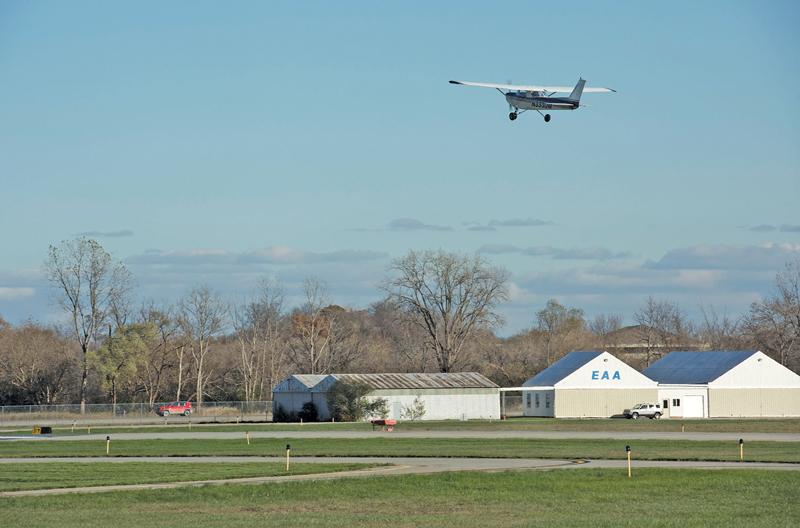There have been repeated attempts to extend the airport’s runway over the last forty years–and every time, city council has shot them down. The most recent dates to 2009, and the final environmental assessment went to the FAA and the Michigan DOT early last year. Airport users consider the changes a no-brainer–but neighbors are once again determined to stop them.
“Our existing runway is 3,500 feet,” explains airport manager Matt Kulhanek. The plan now being considered would add 950 feet to the west while removing 150 feet from the east, “so we would net an 800-foot increase.”
He says MDOT recommends the 4,300-foot length, and says that currently, “the tower can’t see aircraft waiting at the east end to take off because buildings are in the way. The FAA has designated this as a hot spot. I wouldn’t say it’s dangerous, but it requires an extra level of caution.” The shift would also facilitate a long-range plan to expand State Rd. into a divided boulevard.
Former airport advisory committee chair David Canter, director of the U-M’s North Campus Research Complex and a licensed pilot, says among airports in its class, Ann Arbor has the shortest runway in the state. “For some of the larger aircraft that use the airport under certain conditions, the runway is not long enough for them to leave fully fueled or fully passengered,” he says. “And the extra runway would make it a little safer for everyone.”
“You can never have too much runway,” quips current airport advisory committee chair Peter Greenfield, a retired Delta pilot and a part-time instructor at the airport. “But you can have too little!”
Canter says the extension wouldn’t change the type of planes using the airport, and Kulhanek says it wouldn’t increase the number of operations. “It’s not ‘if you build it, they will come,'” Kulhanek says. “What changes traffic is how the economy is going and how aviation fuel prices are, with or without the [runway] extension.”
The estimated cost is about $3 million, none of it from the city. “The FAA and the state would pay for it,” Kulhanek says. “Our local share is about 5 percent, about $150,000, and that’ll come out of the airports’ trust fund. The tax on your Delta ticket goes into a pot of money at the FAA, and they dole out the money–and not just to bigger airports but to smaller airports.”
For Canter, it’s straightforward. “What we’re proposing is that the airport should be able to improve itself and solve small problems within its own perimeter under established rules used nationwide.” However, he allows, “there are neighbors who will experience some small changes.”
Kathe Wunderlich and Andy McGill, who live just west of the airport in Pittsfield Township’s Stonebridge development, believe the changes aren’t good or small. “The prop planes are really loud,” says Wunderlich. “But when the jet planes come in, they’re really, really loud.” Despite the airport’s assurances, she and McGill believe more and bigger planes will use the airport if the runway is extended. And moving it west, they add, will bring it closer to Stonebridge and the Canada geese in its ponds.
“The thing we’re most concerned about is the accidents that could result,” McGill says. “Last January, for example, a jet landing at the airport in Howell went 1,800 feet beyond the end of the runway and across the road into a clump of trees. If that had happened here, he would have gone into the row of houses along Lohr Rd. You’d have had a real catastrophe!”
Kulhanek says only five birds have been struck by planes during his decade on the job. “With three, there was no effect and the [pilots] kept going. Two made precautionary landings, and again there was no damage.” As for noise, he says that studies show that even with the extension, “all the areas over [the FAA limit of] 65 db are on our property.”
Mayor Christopher Taylor says he doesn’t have “an established position. This is an issue that concerns residents and elected officials in Pittsfield Township, and I suspect they would be unhappy if the airport runway were expanded.”
They certainly would. “We will exhaust all means necessary to oppose this runway expansion,” vows Pittsfield supervisor Mandy Grewal. “If the city decides to move forward, we’ll likely have to engage legal counsel.”
It may not come to that. Unlike earlier efforts, the project has no obvious champion on city council–and at least one obvious opponent, Ward Four’s Jack Eaton, who has constituents under the flight path. And city administrator Howard Lazarus remains unpersuaded.
“The real question to ask is whether or not having that airport provides any benefit to the city and the region,” Lazarus says. “My mind is still open on that question.”
